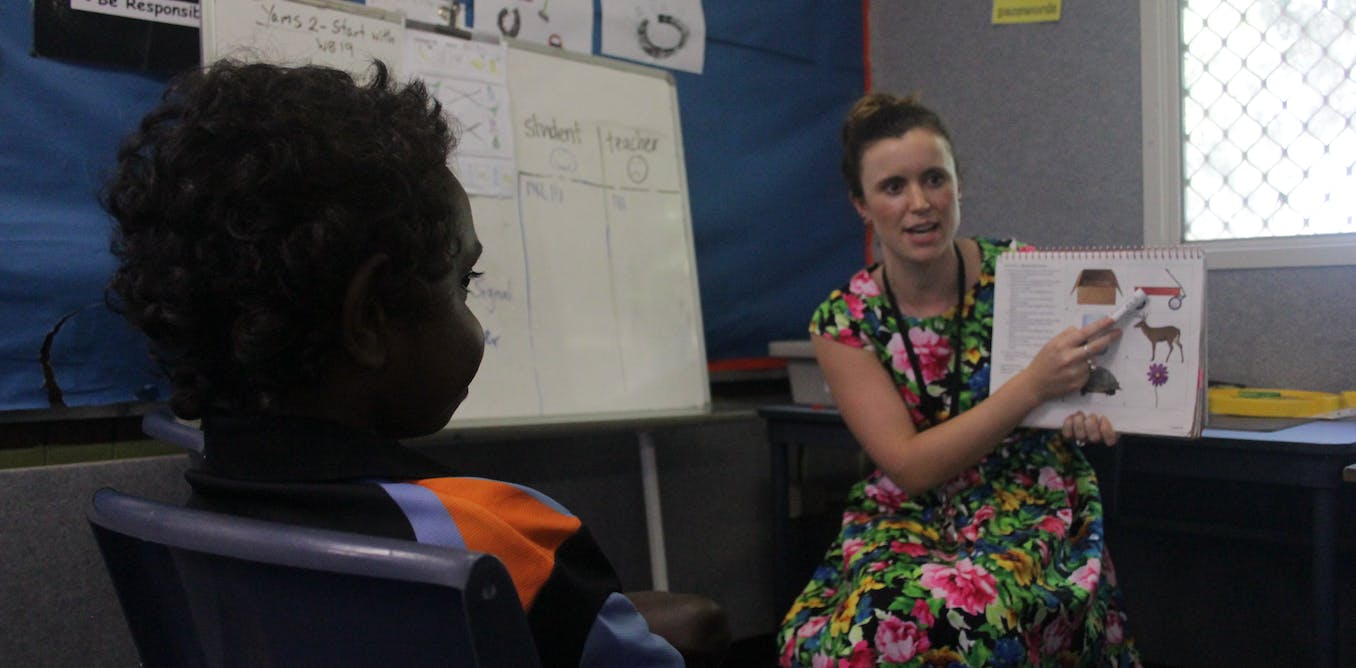Aboriginal and Torres Strait Islander peoples’ school experiences are often inaccurately described through what researchers call “deficit perspectives”. This means their experiences are spoken about by others in ways that aren’t representative of lived experience.
It is rare to hear from Indigenous students and young people directly in research and reports.
Indigenous students, their parents and their teachers shared their experiences as part of the federal government’s ongoing “Footprints in Time” study. Our research using this data set illuminates Indigenous primary school experiences.
Our findings show young Indigenous school students are engaged in their school lives. But they and their families still experience significant levels of racism and want more teaching of Indigenous culture and language.
Meanwhile, teachers say they do not have adequate training to value and teach Indigenous cultures in their classrooms.
Our research
Footprints in Time is also known as the Longitudinal Study of Indigenous Children. Since 2008, it has followed the development of Indigenous children to understand what they need to grow up strong.
It involves annual waves of data collection and follows about 1,700 Aboriginal and Torres Strait Islander children living in urban, regional and remote locations. Interviewers have spoken with more than 1,200 of the original families for most of the study’s 15 years.
Our new primary school report has been produced as the majority of children in the study have now completed primary school. For this, we used data collected between 2009 and 2019.
Here are some of our early findings, ahead of our full report due to be released in mid-2023.
Students are engaged
There is a prevailing assumption in education debates that school engagement is a struggle for Indigenous students and their families.
Yet more than half of the children in this data set were very highly and consistently engaged with school right across the primary years.
Parents’ trust and engagement with schools was also high – with high rates of visiting the classroom (76%), attending school events (76%), talking to other parents (72%) and contacting the teacher (68%).
How can Australia support more Aboriginal and Torres Strait Islander teachers?
Racism is a problem (despite what some teachers think)
Our report found a disconnect between teachers’ approaches to cultural identity, the training they have received and racism experienced by parents and students.
Many teachers spoke of taking a “colourblind” approach, with teachers having the general sense racism is not an issue in their classrooms.
As one teacher noted:
I aim to treat each child the same as any other in terms of race. I also aim to teach this to my students. I emphasise that a colour or religion is not what makes us different.
Another teacher stressed students were simply treated the “same” to foster a culturally inclusive classroom:
We treat ALL students the same. Culturally our students don’t know they are different/same; five out of six are Aboriginal students.
But this approach does not appear to be working. Almost a quarter (24%) of students said they had experienced racist bullying at school, while 22% of parents said they had experienced racism at their child’s school.
Meanwhile, 53% of teachers also said they had insufficient cultural competency training.
Despite many schools noting that they celebrate Indigenous days of significance, 41% of parents surveyed reported no or limited representation of Indigenous teachers or staff at their child’s school.
Racism hits Indigenous students’ attendance and grades
Time to change homework approaches?
Teachers were asked what strategies they used to encourage parents to support children’s learning at home. Of more than 400 responses, homework was in the top three. This included weekly homework to revise what is taught in class, as well as readers and flash cards.
This was despite there being little evidence for academic benefits of homework in the primary years.
When asked what they would like to change about school, children reported reduced homework. They also said they wanted to see less staff turnover, better play areas and less bullying.
Opportunities to learn Indigenous languages
While learning to read and write in Standard Australian English is important, so too are Indigenous literacies and languages.
Almost 90% of parents surveyed said they wanted their child to learn an Indigenous language at school, but only 21% of children had this opportunity. Most teachers (57%) reported their schools were not delivering an Indigenous language program.
There was also very little access to specialist language teachers in remote areas, despite the fact most children in the study who had an Indigenous language as their first language lived in remote regions.
Primary school teachers most frequently reported they would benefit from learning to teach Indigenous children successfully (61%), followed by learning about Indigenous culture in the local area (59%), and then learning to teach Indigenous knowledge appropriately (58%).
Roughly 18% of teachers were confident they had sufficient training. Overall, an average of 84% of teachers across the primary years said they felt they would benefit from some form of additional training. This reflects the words of one parent who shared their own experience at school:
I was always proud to be Black, but we didn’t learn any (Indigenous) history.
Tradition and innovation: how we are documenting sign language in a Gurindji community in northern Australia
What next?
Our report highlights several areas where we can make positive – and necessary – changes. These include:
improve cultural competency training for teachers. This training is the responsibility of schools, policy makers, and universities alike
professional learning should explicitly address race-based bullying and racism, providing teachers with clear strategies to put into practice
it is essential that teachers personally reflect on their approaches and how a “colourblind” approach may not be working
teachers should act to strengthen relationships with families and build opportunities for engagement with parents throughout the primary school years
we need to make Aboriginal and Torres Strait Island histories and cultures a national priority across the curriculum. It should be delivered fully and universally, regardless of location, and Aboriginal and Torres Strait Islander student numbers
homework policies across primary schools in Australia should be transparent and evidence-based. Consideration needs to be given as to whether homework is an engagement barrier for Indigenous children
the overall lack of provision of Indigenous language programs is of significant concern and a national plan to address this should be a top priority for government.
The National School Reform Agreement
These priorities should be addressed in the next National School Reform Agreement.
The agreement is a joint agreement between the Commonwealth, states and territories, designed to lift student outcomes in Australian schools.
The current agreement will expire in December 2024. And the new one is now being examined by an expert panel, with a report due in October. The government has asked it to look at supporting students, student learning and achievement, attracting and retaining teachers and data collection.
Indigenous voices are key to improving each of these areas and should be central to future discussions.




